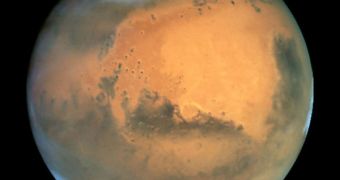For all you Mars fans out there, tired of shuffling through endless galleries on various sites in order to find information of use about the Red Planet, Google and NASA have decided to create Google Mars 3D, a new computer software meant to give each of its users the opportunity to thoroughly inspect our neighboring planet, and to scout its mysteries. The Martian terrain will be presented at very high resolution, as well as in a 3D view, which will significantly improve every individual's understanding of how the craters and the mountains of Mars look like.
"They can fly to the top of Olympus Mons, the tallest volcano in our solar system, read geo-located excerpts about different locations on the planet from 'A Traveler's Guide to Mars,' observe where various Mars rovers and landers have touched down, and much more," an announcement made by officials from Google says. They add that the new software platform is built in such a manner, that it allows all users to add their three-dimensional content to the Martian map, so everyone can see it.
The Ames Research Center in Moffett Field, California, has collaborated with the Internet search engine company on behalf of NASA, providing a large array of high-quality photographs and panoramic imagery. In addition to working with NASA, Google has also joined forces with the Carnegie Mellon University, the SETI Institute, and other space research organizations, and has managed to persuade them to share some of their pictures with the audience.
Google Mars 3D will be available as a mode incorporated in Google Earth, and will give users the possibility to "fly-through" Mars' canyons and craters, as well as to tap into a direct view of the Martian soil, through the eyes of the Spirit and Opportunity rovers. For larger pictures, the program will use data and imagery from NASA's Mars Reconnaissance Orbiter, located above the Red Planet.
It remains to be seen if the program will catch on quickly with people, but representatives of both NASA and Google are confident that this is bound to happen, especially considering the interest the two Martian twin rovers Spirit and Opportunity got after they entered their fifth year of mission on Mars.

 14 DAY TRIAL //
14 DAY TRIAL //